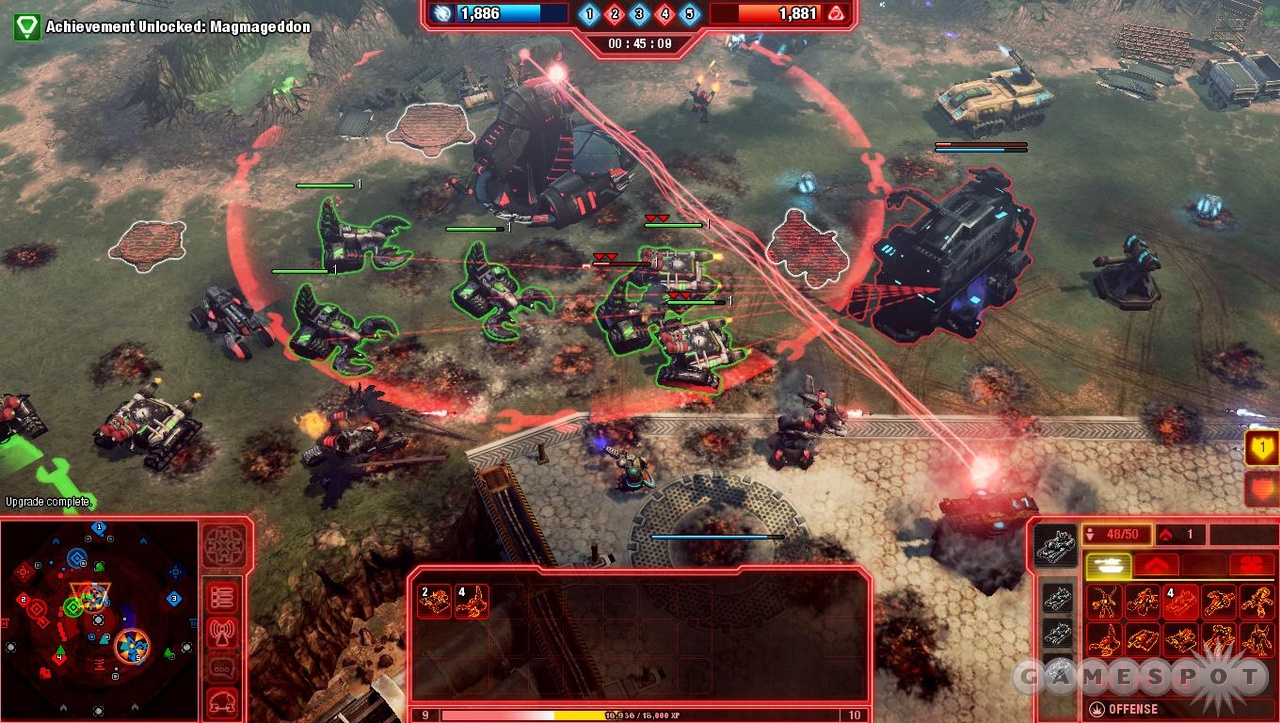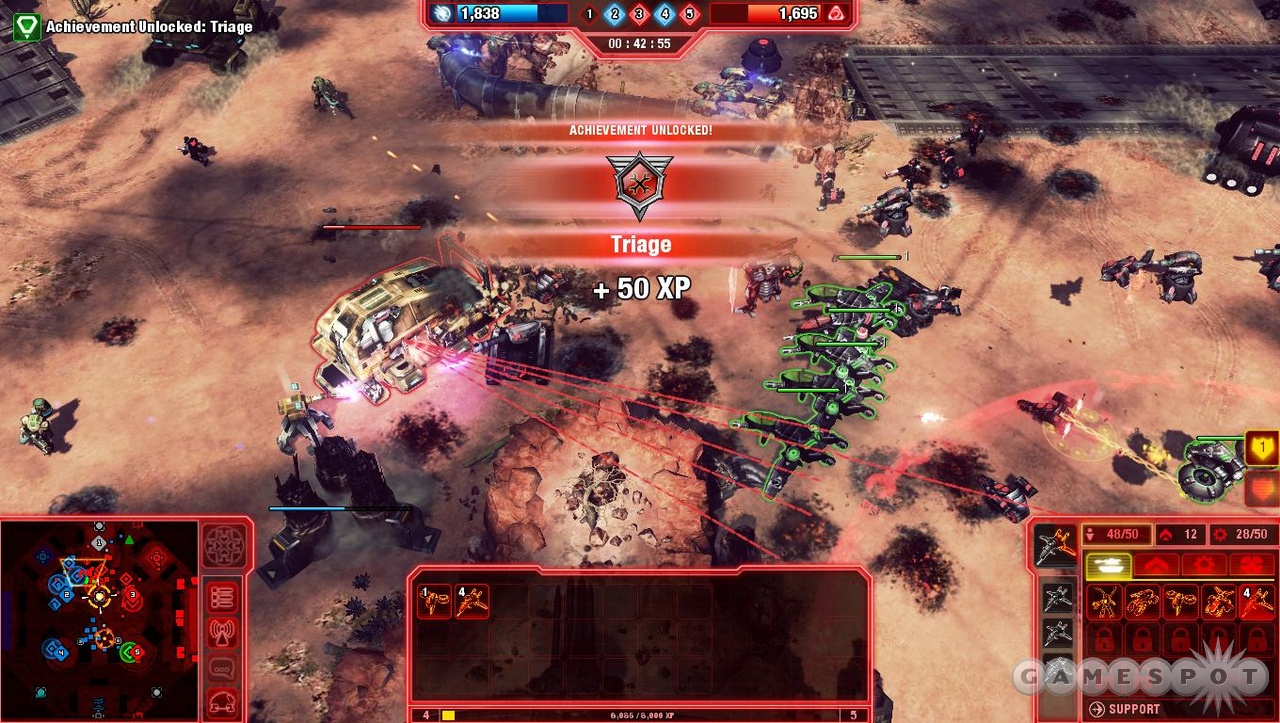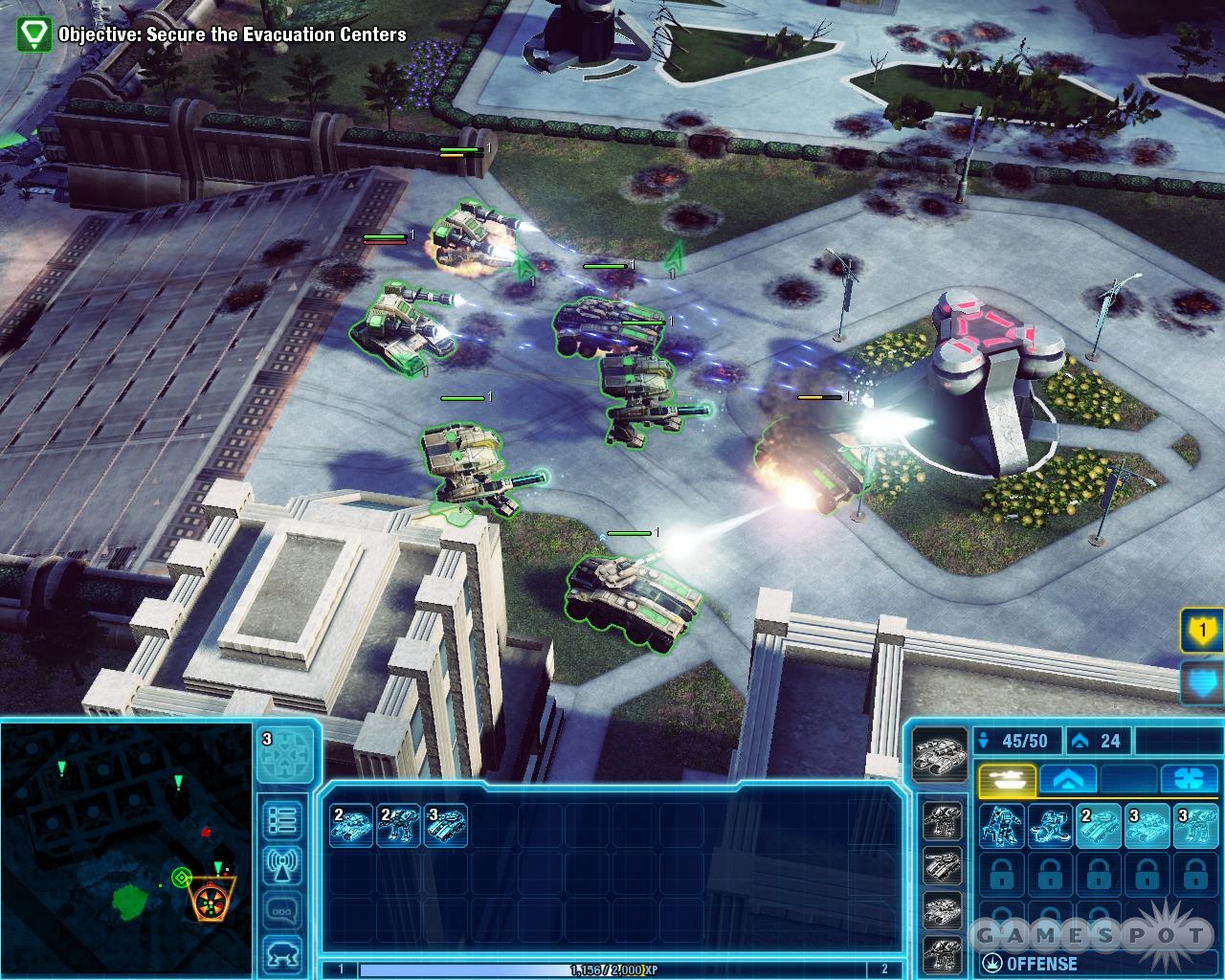There's a good chance that Command & Conquer 4: Tiberian Twilight is not what you were expecting. This real-time tactical game shares some attributes with the Tiberium-fueled strategy games that came before it--flashy graphical effects, GDI and Nod forces pummeling each other, and a scowling antihero with a stare so intense his eyes pierce your soul. But Tiberian Twilight stands out not for its use of age-old series standbys, but for reinvented mechanics that have little in common with those of its predecessors. Base-building and broad strategizing have been supplanted by small-scale micromanagement; standard battles have given way to capture-point conquest. It's a bold shift for the apparently final chapter of the saga, though not always a positive one. The disappointing campaign ends in a conclusion unworthy of Kane's melodramatic legacy, and the moment-to-moment gameplay is too limited to be consistently engaging. And yet the multiplayer action and single-player skirmishes are good fun, if not remarkably so, and a system of persistent unlocks provides nice rewards across every mode. This may not be the exhilarating finale to Kane's exploits you had hoped for, but Tiberian Twilight is a pleasant diversion good for occasional grins, though not for riotous thrills.
Those persistent unlocks are central to the experience--one that takes place in an always-online environment. Even if you plan on playing only the single-player campaign and skirmishes against the artificial intelligence, you must always sign into an online portal first. This always-online approach to PC games is part of an unwelcome but growing trend, but at least the game provides some sensible context for it. Like most strategy games, Command & Conquer 4 offers a single-player campaign, offline skirmishes, and online battles; but unlike most strategy games, it rewards you with experience based on your activity in every mode. No matter which mode you play, finishing a match inches you closer to your next level. Gaining levels means new units, new powers, and new upgrades--goodies that you can then take with you into any of the modes. This persistency, along with the way you automatically join online chat and can create player parties from the main interface, contributes to a pseudo-massively-multiplayer environment. This isn't a massively multiplayer game, of course, so it's still a disappointment that you can't practice your skills or get reacquainted with Kane if a windstorm knocks out your Internet connection. Nevertheless, this focus on community and advancement makes the online-only requirement bearable, if not wholly reasonable.
Yet Command & Conquer has been just as much about hammy acting and over-the-top plot developments as it has about online competition. Actor Joe Kucan once again fills the shoes of Kane, the sociopathic leader of the Brotherhood of Nod--a messiah to a cult of blind followers seeking "ascension." Tiberian Twilight is the final entry in the series, at least where Kane's story is concerned; revealing too much here could risk spoiling some of the campaign's surprises. Melodramatic live-action cutscenes feature Kane and other key characters speaking directly to you, and as you'd expect in a C&C game, the actors chew up the scenery with broad body language and tragicomic line delivery. Yet this story takes itself somewhat more seriously than previous ones did. The sets don't look so low-budget this time. The lighting is dark and oppressive. The excellent (if sometimes bombastic) soundtrack enhances the darkness with poignant jabs from oboes and bassoons. Kane is even more intense, more frightening, and yet more vulnerable too.

The campaign's most interesting facet is that after a few missions that serve as a tutorial, you make a decision: side with Kane and join the Brotherhood, or stick with the more law-abiding Global Defense Initiative--that is, GDI. You are still able to play out the story from the other side of events no matter which faction you initially choose, and it's admittedly fascinating to experience events from both angles. Either way, however, it's hard not to be disappointed by the flaccid ending, which hardly grants Kane the grand send-off such an iconic and deliciously self-important figure deserved. Perhaps this lukewarm departure is disappointingly fitting, however, as the campaign itself isn't grand either, but rather occurs on a smaller magnitude than you may be used to in a Command & Conquer game--in terms of both length (the campaign will probably take you six or seven hours to complete) and strategic scale.
That smaller scale is Tiberium Twlight's most obvious change over its predecessors. Command & Conquer 3's lengthy campaign was notable for several exciting large-scale missions spread across multiple fronts. By contrast, C&C4 puts you in control of a relatively small force whose size is limited by a predesignated number of command points. You order up units from your mobile base, called a crawler. Each unit costs a certain number of points, so your unit cap depends on the units you create, with larger and more powerful units costing more to build than smaller ones. In the team-based, five-versus-five online skirmishes, this format has its limitations but still makes for battles that can be fun to manage. (More on this to come.) But the campaign feels restrictive. As a rule, you simply lead around the same control group from spot to spot as you complete your mission objectives. In this respect and in others, Tiberian Twilight shares some similarities with last year's Dawn of War II. But the campaign of Relic's Warhammer 40K-themed opus was notable for its compelling you-versus-the-hordes pandemonium and role-playing-style looting. By comparison, this campaign plods along on smaller maps, offering few thrills, no unit customization, and little sense of forward momentum. You can invite a friend to join you cooperatively, in which case two players lead their own lone control group around. This is one of the few cases in which adding a friend doesn't turn up the volume.
To see Command & Conquer 4 at its best, you need to venture into multiplayer battles or, at the very least, play skirmishes against the AI. Smart tactics and micromanagement are far more important once you leave the tepid campaign behind. One of the game's most intriguing elements is the idea of combat roles. At the beginning of each match, you select both a faction and a role: offense, defense, or support. A crawler of that role then drops into your team's spawn zone, and you can start churning out units and moving your crawler to the most tactically relevant regions of the battlefield. (Most campaign missions also let you choose a role but rarely give you a reason to change things up; you can just roll through in whatever role you prefer every time.) Offense means firepower on the ground: Nod's Scorpions and flame tanks, for example, or GDI's Mammoth tanks and Mastodons. If you select defense, you take protective measures by creating turrets, infantry that can be garrisoned in structures, and other associated units. Choosing a support walker means taking flight. Not only do you get powerful and familiar aircraft like Orcas and Venoms, but you gain access to effective healers and other helpful units.

And so two armies--Nod and GDI--fight for control of the Tiberium Control Network towers spread across the map. This mode is called Domination, and it's Command & Conquer 4's only online mode. If you've played a Conquest game in the Battlefield series of first-person shooters, you know what to expect. Getting units close to a tower and keeping them there long enough captures it; controlling more than your enemy does causes your team's point ticker to rise. The more nodes you hold, and the more enemies you kill, the faster your point total moves upward until a team reaches the point limit and is declared the victor. Some mechanics seem built to keep you constantly engaged. As long as your crawler lives, you can keep churning out units, constrained only by the number of command points. Should you lose your crawler, you can summon another one to a spawn zone after a brief wait. In fact, there will be moments in which dismissing your crawler and summoning a new one of another class is the appropriate move should you notice a gap in your team that needs filled.
Yet while some gameplay features are meant to keep you busy, others make Tiberian Twilight feel too limited. At its furthest zoom level, the camera still remains close to the battlefield. Even when granted speed upgrades, units move relatively slowly. Units' aggro ranges are surprisingly restricted. The skirmish AI isn't all that great and often does really dumb things even on hard difficulty. So while the game cribs from Dawn of War II and World in Conflict, it doesn't capture their intense, fast-paced thrills. Nevertheless, matches can still be a lot of fun when you get two evenly matched teams struggling over control points. Taking over the husk of a powerful fallen unit like a Nod Avatar with an engineer can help turn the tide of battle; capturing a tower with stealth units right under the enemy's nose is always enjoyable; and skirmishes can get particularly intense when both teams are close to victory and one desperately needs to gain control of another tower. There's also a bit of a capture-the-flag element layered on top of this structure by way of Tiberium crystals that spawn in at designated spots on the map. You can capture these crystals with ground units and transport them back to a spawn region, which earns you points that you can then spend on powers (spawn a field of mines on the battlefield) and unit upgrades (improve unit reload times), or on unlocking the next tier of units. Of course, this is assuming you have already leveled up high enough to access them at all.

Matches make for short-term entertainment, and the persistent experience you earn in every mode is always dangling the promise of cooler toys in front of you. This will keep you occupied until you unlock every available unit and upgrade, which will take most people a few days. Until that time, you will likely need to endure the imbalances intrinsic to leveling. You may face players who have access to units and powers that are superior to yours, and there's not a whole lot you can do about it aside from reaching the same level. If you create a custom game, there's no way to limit the match to players under a certain level--you can't even give a custom name to the match you host. Once you've reached the level cap, it's hard to overcome the sense that you're just always throwing a single bunch of units into the fray, at least during five-versus-five battles. Matches with fewer players grant you more command points, which gives you more opportunities to handle multiple battlefronts at once. This allows you to keep occupied across the entire map rather than in one or two hot spots, though even then, Command & Conquer 4 doesn't match the busy pace of its competition, and doesn't have the flexibility and scope of its predecessors to help compensate.
So no, this isn't the Command & Conquer you remember, though that isn't to say it isn't good. In fact, online play is rather fun when two equally matched teams are going at it, warring over those all-important towers and nabbing Tiberium crystals. It's a good-looking, nice-sounding game with the thick and colorful C&C attitude you hoped to see. Yet the limited focus and flabby campaign make Tiberian Twilight a disappointment nonetheless. This is a good game, but such a renowned and beloved character as Kane should have received a more explosive goodbye.